Lenovo Yoga 3 Pro Review: Refreshed With Faster Core M
by Brett Howse on March 13, 2015 8:00 AM ESTBattery Life
With a similar display and a smaller battery, Lenovo will need to have upped their overall system efficiency to come close to the Yoga 2 Pro. The Yoga 3 Pro has a 44 Wh battery, as compared to a 55 Wh in the Yoga 2 Pro. Core M is certainly going to be more efficient than Haswell-U, but it is still a big ask to drop the battery size by 20% and keep the battery life the same. As we saw with the XPS 13, high resolution displays are a big hindrance to overall battery life.
To test battery life, we set all of the displays to 200 nits, and the laptop is set to power saving mode. Our light test consists of web browsing, and for our heavy test we ramp up the number of pages loaded, add in a 1 MB/s file download, and play a movie.
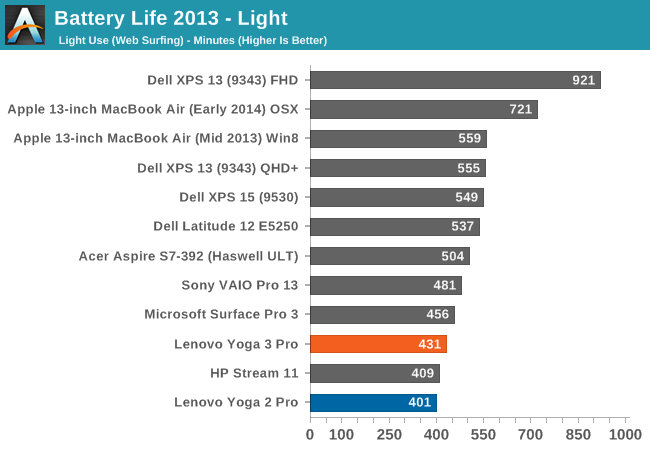
The Yoga 3 Pro manages 30 additional minutes over the Yoga 2 Pro on our light test, which is more of a test of display efficiency than CPU, since the CPU is not being worked very hard. It may seem like a poor score, but due to the smaller battery size in the Yoga 3 Pro, it is certainly an improvement. It will not give you the all-day battery life of the XPS 13 though. With the same resolution display, the XPS 13 gets an additional two hours of battery life, but it also has a 52 Wh battery.
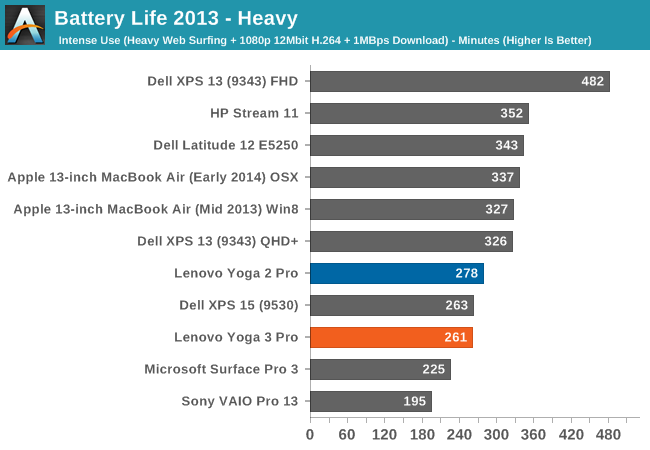
On our heavy test, the Yoga 3 Pro drops behind the Yoga 2 Pro in battery life, and falls well short of other Ultrabooks. The XPS 13, with the same resolution display, manages just over an hour more battery life in this test. We also like to look at a normalized score which takes the battery size out of the equation so we can look at overall efficiency of the system.
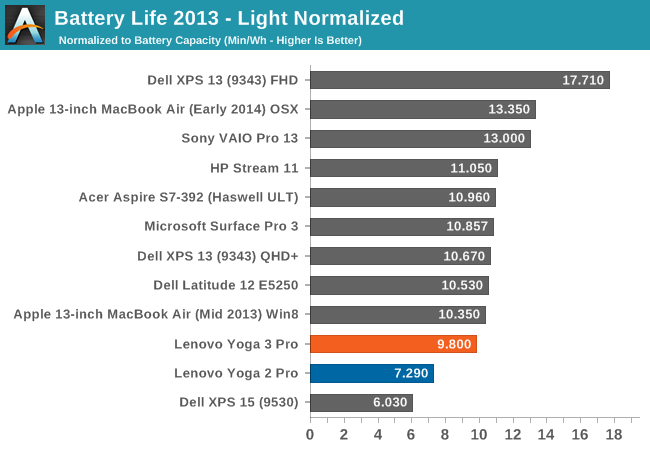

Here we can see how much progress Lenovo has made over the Yoga 2 Pro. On our light workload, the Yoga 3 Pro is much more efficient than the Yoga 2 Pro, and comes close to the competition. The XPS 13 is still a bit more efficient though with the 3200x1800 resolution, which is the main power draw in this test. On the heavy score, Lenovo is once again quite a bit higher than the Yoga 2 Pro, and is inching in on the MacBook Air and XPS 13. They are not quite there though, which makes the smaller battery choice have an even greater impact on the overall battery life.
Battery Charge Time
One aspect of mobility is battery life, but charge time can also play a factor. The Yoga 2 Pro had a larger battery, and also came with a larger charger.
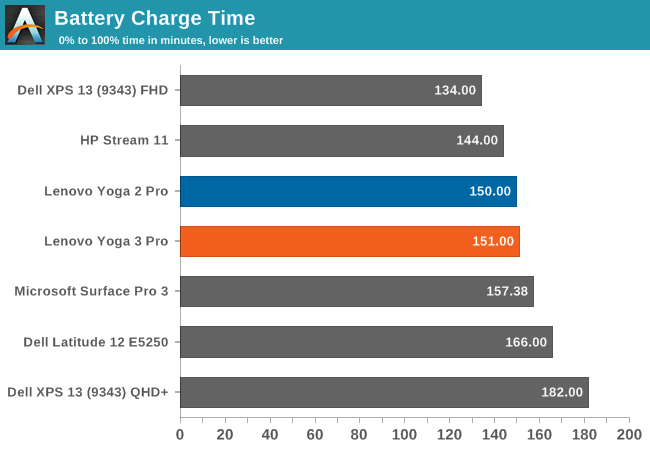
The Yoga 3 Pro charges roughly the same as the Yoga 2 Pro. It would have been nice to see a faster charge rate here though due to the smaller battery size, but that is not the case.
The Yoga 3 Pro does not spend very much time hovering around 99% like some devices do, and the charge rate is very linear until over 80%.
Wi-Fi
One of the pain points on the Yoga 2 Pro was the included single band Wi-Fi card. The maximum connection speed on the Yoga 2 Pro was only 300 Mbps, and sustained transfers are much lower. Lenovo did replace the single band card with the Intel Dual Band Wireless-AC 7260 later in the model run, which improved matters quite a bit. For the Yoga 3 Pro, they have switched to a Broadcom 802.11ac solution, which offers connection speeds up to 866 Mbps.
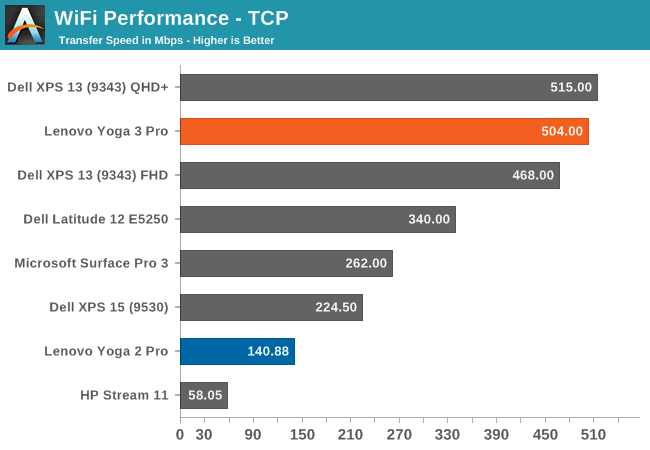
On a $1000+ device, the Yoga 2 Pro had unacceptable wireless performance, but the Yoga 3 Pro suffers no such indignities. The Broadcom 802.11ac solution is one of the fastest we have tested on various platforms, and here again performance is very good with over 500 Mbps transfer rates.
Speakers
Lenovo has upgraded the speakers in the Yoga 3 Pro as well. JBL now provides the two speakers, and they are powered by a 1.5 watt x 2 amplifier. In addition, they have implemented WAVES MaxxAudio, which switches the speaker profiles depending on which mode the device is in. The Speakers are down-firing when in laptop mode, but fire up in Stand Mode, so they have a different equalizer mode for each orientation.
I tested the dB output in all four modes. The loudest was in laptop mode, where I hit about 80 dB playing music with the meter 1 inch over the touchpad. This is not a very strong result, and I would classify the Yoga 3 Pro as a device which cannot fill a room with music. The next loudest was tablet mode, at 76 dB, followed by tent mode at 73 dB and stand mode at only 67 dB.
Looking at the frequency response of the Yoga 3 Pro, we have not the best result either. The push to make devices thinner and thinner means that there is not a lot of room for quality speakers. The Yoga 3 Pro has almost no response at all below 200 Hz, and really there is not much response at all below 400 Hz. As great as the design of the Yoga 3 Pro can be for media consumption, the speakers leave a lot to be desired.
Noise
Even though the Core M can be put in a completely fanless device, Lenovo has included a fan to keep the temperatures down. On balanced or power saver configurations, the fan is normally either off, or on very little. During workloads, the fan can kick in, and for the most part it is fairly quiet. It is certainly audible though. The noise floor in my room is 35 dB, and at low loads, the fan would kick on around 36.3 dB. Heavier workloads would ramp up to 37 dB. So it is not overly loud, but you can hear it.
Software
Due to recent events, included software needs to be brought up. The Yoga 3 Pro that was sent as a review sample did not have Superfish, and Lenovo has stopped installing it on new devices. This was a major blow against Lenovo’s reputation, but it also brought to light how much extra software is installed on PCs, and made people realise that they not only do not need it, but it can harm the experience, and possibly their system security.
The Yoga 3 Pro does come with quite a bit of extra software. Some of it, like the Harmony software, is kind of useful. Some people may also enjoy the trial version of McAfee. A lot of it is not very useful though, at least not for me. I can’t speak for everyone out there, because if I say software X is not useful, I am sure someone will disagree.
I am not here to defend Lenovo for Superfish. It was clearly a bad idea from the start, and I am sure there has been some fierce internal discussion within the company about how they even fell for it.
The only good thing to come out of Superfish was that it has woken the industry up, and they are taking action. Lenovo has stated that they are going to “significantly reduce preloaded applications” and they want to be the leader in cleaner PCs. They have stated that by the time Windows 10 is launched on Lenovo products, they will only include the OS, hardware drivers and software to power said hardware, security software, and Lenovo applications. This will be a good step, because it has become a big problem. Hopefully they will go far enough.
For those that are still wary, any PC purchased from a Microsoft Store will be a “Signature Edition” of that device, and all bloatware will not be installed.


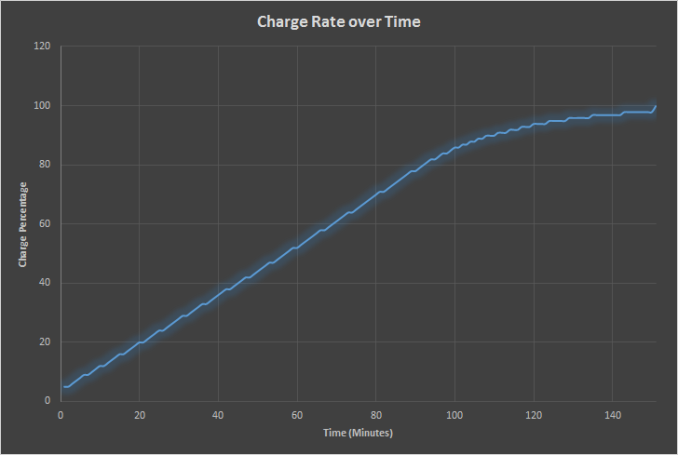
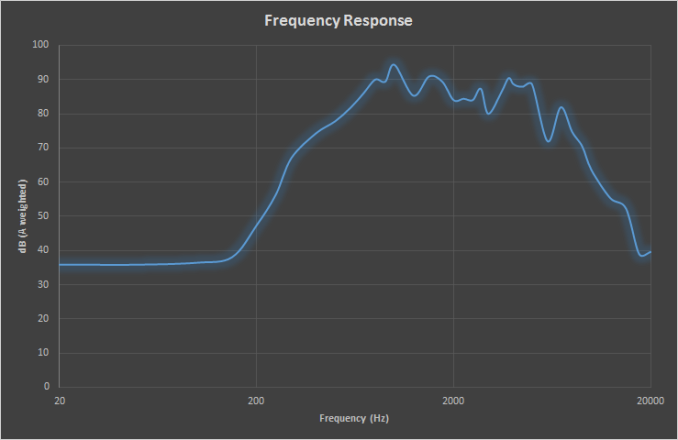
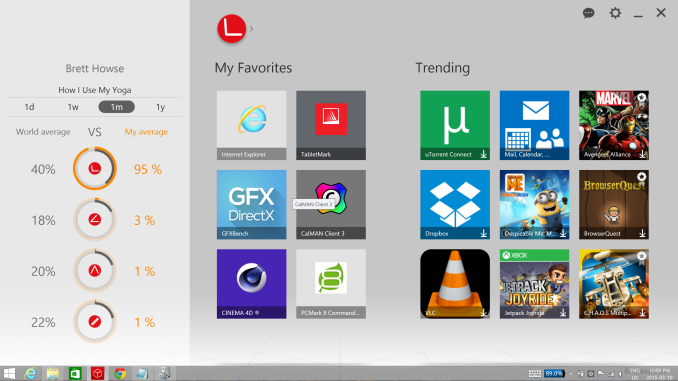








113 Comments
View All Comments
coolhardware - Friday, March 13, 2015 - link
I'm hoping Lenovo follows in Dell's footsteps and gets rid of the bezel around the screen along with big wasted area around the keyboard.Pretty sweet to get the same display size and pixel density:
13.3″ 75.59 square inche display (11.6″x6.5″) 3200×1800 16:9 Ratio 276.05 PPI
***all in a much smaller form factor!***
*Source for display specs: http://pixensity.com/list/laptop/
fokka - Friday, March 13, 2015 - link
the thing is for the tablet mode it's nice to have some bezel to grip the whole thing, so going the minimal bezel route like the xps 13 wouldn't be the most comfortable thing on a device like a yoga 3 pro.that's the same reason we have the big wasted space around the keyboard: that's where you hold the device in tablet mode. i think they still should have given us at least a row of half-height function keys, but we see that a convertible is always a compromise.
fokka - Friday, March 13, 2015 - link
agreed. the hinge might look nice to some and as long as it works it's fine by me, but if they go ahead and bost about it consists of over 800 parts, that just screams "over engineered" to me.i also don't see how a simple hinge has to look like a watchband, or a piece of jewelry and again: using 800 parts, when you could reach the same goal with just two is simply too much in my book.
Cook-e-Monster - Friday, March 13, 2015 - link
Hugely disappointing to see the keyboard get compromised like this. one of the most useful things about Lenovo is that they make good keyboards with intelligent layouts. Nixing the F-row and hamstringing the PgUp/Down and Home/End keys is probably a deal breaker for me.I really hope that there's a review coming for the recent HP Spectre. I think it (and the XPS) has Lenovo beat this year
Sushisamurai - Friday, March 13, 2015 - link
I appreciate you linking the notebook bench link, but the Lenovo Yoga 3 Pro isn't listed on your bench results yet (nor in CPU bench). I was also hoping there would be more of an in-depth discussion about the Core-M CPU and probably a few more "real life" use case results and short comings of the CPU, as this is Anandtech's first product review with a Core-M.I like how you included Dell's XPS 15, but for those unfamiliar with that model, I think you should have at least mentioned what CPU it was other than being a quad-core CPU. Without bench results, it's also hard to compare what core-M's performance is compared to other broadwell/Haswell offerings as the charts are comparing tablets and some Haswell-U's. I think it'd be an interesting dive to see what users would be sacrificing in terms of performance to go to Core-M (form-factor) versus intel's bigger mobile processors. I suppose I could wait for the bench results and pore over the charts myself, and since anyone can do that, that's not why we read anandtech.
Brett Howse - Saturday, March 14, 2015 - link
Sorry the Yoga 3 Pro was in Bench but not enabled for public viewing until after I posted. I just enabled it now.I did mention in the article that the Dell is a quad-core part. I have some more ideas as well to make that more clear but it's a backend thing.
Look for more Core M discussion soon. We had issues getting samples at the start since it seemed like a really slow release but we have some now. I've got a couple more Core M devices in my queue to look at.
Sushisamurai - Sunday, March 15, 2015 - link
Sweet. I'm looking forward to more core-M reviews. I think a lot of our readers are interested in reading what you guys have to say about the new MB apple released.Also, I'm aware other products' performance is listed in bench but it would be nice to include products that match the one you're reviewing in terms of size, form factor, and price - I felt that the products you included in your charts were heavily skewed to tablet comparisons, where we could have used some more comparisons for products in similar price ranges.
Otherwise, good read, thank you for your hard work.
sandineyes - Friday, March 13, 2015 - link
I actually bought a Yoga 3 Pro (my first laptop in over 10 years) during the holiday season, and eventually returned it after a few weeks. My thoughts:-The build quality on this thing is pretty poor for such an expensive device. The panel on the back of the screen on mine flexed quite a bit, as if it didn't fit perfectly. Similarly, there is a piece of plastic below the display that looks like it is fit into a rectangular slot, and that wiggled around too, as if it was glued poorly or something. It also shows usage very poorly; no amount of hand washing prevented it from looking like a mess after using it. I had a chance to touch a MBP while I owned this, and that felt markedly better made.
-The screen is not very good. It wasn't really that much of a problem, and the article mentions it getting better in the refresh, but mine was pretty poor. It was also my introduction to HiDPI Windows and all the caveats that come with that. I am also used to my 16:10 desktop monitor, so I'm probably a bit biased. But seriously, we need more 16:10 laptop screens that aren't on Macs.
-It generally felt fast enough, but mine could not handle HD streaming on Amazon Instant Video (tried Chrome and latest IE). The video would start stuttering, making it un-watchable. Netflix didn't have this issue, and neither did a 1080p video stored locally when used with VLC. I don't know if the refresh has this issue, but it made Amazon Instant Video a last resort.
-The battery life is terrible. I am not really used to laptops, so for me the 5 hours of life I managed out of the thing felt very oppressive. And although this is a minor issue, the included charging cable is too short.
-The last laptop I owned had physical click buttons; my index finger worked the pad, and my thumb rested on the left click button. Based on the Yoga I cannot see how people have adapted to use these new-fangled track pads with no buttons. It is like we've actually regressed in technology over the last 10 years when it comes to this. Getting click and drag to work on these damn things is real challenge.
-Make sure you keep that Harmony software installed; otherwise the computer won't properly deactivate the keyboard and track pad when in stand mode.
-This computer makes me want more, better hybrids to exist. Because of the utility of stand mode, I do not think I can ever buy a normal laptop or a tablet. The light weight of this thing is also a plus, but I think that is more a benefit to tablet mode, which isn't that useful in comparison to the other modes.
fokka - Friday, March 13, 2015 - link
thanks for your quick review, it's interesting to hear some real life caveats, even if you didn't use the latest model.i also share some of the same complaints about at least some of the current ultrabooks. i recently got to test an asus zenbook (ux301la) and while it looked stunning with its white glass finish, it only stood on three of its rubber feet and kept wiggling, as you moved your hand to and from the palm rest. even the (buttonless!) glass touchpad made a slight squeaking sound, when you moused around on it.
it seems to me that many manufacturers have a problem converting those nice press renders and incredibly high specs into really usable products that don't show some serious flaws after a short amount of time.
many people say this machine (e.g. a zenbook), or that laptop (e.g. the new xps 13) offer incredible build quality, but still i have to see one laptop model to offer such a continuously high build quality as apple does with their whole macbook line. a shame, since i'm really not a fan of osx.
i'm also not the biggest fan of hi dpi screens, especially when the effect is made obsolete due to the use of a pentile matrix. it seems we're just wasting money, energy and gpu cycles, hell, even usability (->scaling), just to have one more spec to boast about. and all this on the machines that are conceptually the worst place to start the dpi-revolution: battery and performance limited mobile devices.
"The screen is not very good." ...if people sum up a screen with those (your) words, i think we can agree that this specific panel was a poor choice on a somewhat premium device like the yoga 3 pro.
and a new $$$$ laptop not managing 1080p playback on one of the biggest VoD services... i think i have seen enough of core m for one day, even if that specific problem turns out to be driver related.
kyuu - Saturday, March 14, 2015 - link
Considering that you can go to the HP website right now and get the Spectre x360 with 1080p touch, 8GB of RAM, a 256GB SSD, a Core-i5 5200U, a much larger battery and what looks like much better build quality all for under $1000, I'm afraid Lenovo needs to do more than this refresh to keep the Yoga line competitive. You can even upgrade to a QHD display for only another $100, if you prefer resolution to battery life. Hopefully you guys get in a Spectre x360 for review in the near future.And if you don't care about a 360-degree hinge and a touchscreen, then the Dell XPS 13 knocks it out of the park.